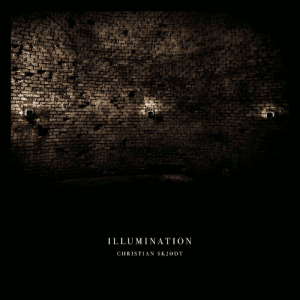 Christian Skjødt‘s Illumination LP was commissioned for an installation of the same name he constructed at the Botanical Garden of the University of Latvia in Riga in 2014. Released on 10″ clear vinyl and digitally, each side is exactly twelve minutes long, and captures a slice in time from the ten solar-powered analogue circuits which he had installed to resonate around the dome of an eighteenth century wine cellar.
Christian Skjødt‘s Illumination LP was commissioned for an installation of the same name he constructed at the Botanical Garden of the University of Latvia in Riga in 2014. Released on 10″ clear vinyl and digitally, each side is exactly twelve minutes long, and captures a slice in time from the ten solar-powered analogue circuits which he had installed to resonate around the dome of an eighteenth century wine cellar.
The first, recorded at noon when the sun was strongest and hence the microtonal textures generated by the instruments transitioned through particular tones, shimmers in a heat haze of drones that must have been quite an experience in person and in the surround-sound environment created in the cellar. On record, the feeling of space and depth is perhaps not as omnipresent thanks to being presented in stereo, but it certainly fills the audio spectrum comprehensively. The image of bees in a hive is perhaps one suggested by the image of a domed space and the July date, but there’s a pleasing affinity with the sounds generated by the insect labour that refers on to the later product of their pollination that was once stored there.
As the drones and harmonics reverberate, they transition according to the elements, and it’s interesting to compare them to the different results found three hours later on the same day. The hundred solar power sources were by then generating at an audibly changed level, the rippling soundwaves humming at markedly altered frequencies around the base Concert A tone which the modules would generate in optimal levels of sunlight. This piece is appropriately more languid than all the noonday activity, connected but laid back, replete with both the memory of the burning energy of three hours earlier and filled with the entropic knowledge that evening, then nightfall, will bring about the day’s end, and with it the quietening of the music.https://vimeo.com/117859257
Illuminations packs a lot into just under half an hour of slowly transforming, essentially quotidian reflection on and transmission of a fragmentary reproduction of how a particular point in time and space sounded, transported from Riga to the speakers, wherever they might now, or in future, be. The way that the two tracks open and close respectively with the sounds of bird chatter, presumably from the gardens, grounds them neatly, and brings the listener into then out from a state of reverie, marking a portal from one environmental simulacrum in microcosm to another. Based on Carl Nielsen‘s String Quartet In F Minor (Opus 5), Dissolution And Suspension celebrated the composer’s 150th birthday with a quadrophonic deconstruction of the work’s four movements into a spectral, shifting re-imagining of the original.
Based on Carl Nielsen‘s String Quartet In F Minor (Opus 5), Dissolution And Suspension celebrated the composer’s 150th birthday with a quadrophonic deconstruction of the work’s four movements into a spectral, shifting re-imagining of the original.
Once again, Skjødt’s interest in how sound acts through time and space was deployed by separating four distinct variations on recordings of acoustic instruments into parts broadcast through individual speakers so as to place the listener within the ghostly vision of a quartet. Except of course this recording is once again a stereo rendition, but while some of the spatial experience has needed to be compressed into two channels of audio, the separation and shifting sense of movement across the soundscape is nevertheless effective and involving enough on its own merits.
There is a calming sense of stillness to the way in which Nielsen’s work has been interpreted as an electronic sublimation of the original into a piece which, while constantly in motion, speaks broadly with a still and almost anticipatory sense of time being suspended, of tones and timbres floating and evolving at their own sedate pace. Stripped of the original melody, Skjødt instead offers a textural journey through a cosmic dreamscape where the low end thrums gently in the bass registers, rumbling up into a slowly unfolding cloud of sound that more closely resembles post-rock drifting than it does the formalities of the string quartet. Meditative while remaining involving at the same time, Dissolution And Suspension inhales and exhales, breathes at its own pace, unfolding in a series of slow-motion rounds filled with a sense of the sublime and an eloquent stasis. It reaches a peak in the third movement, a dramatic unfolding that is then recapitulated into the fourth and final descent into reverberent channel-switching flows that eventually shake off their mantle of electronic processing and allow the cycling strings their moment of recognition.-Antron S Meister-



